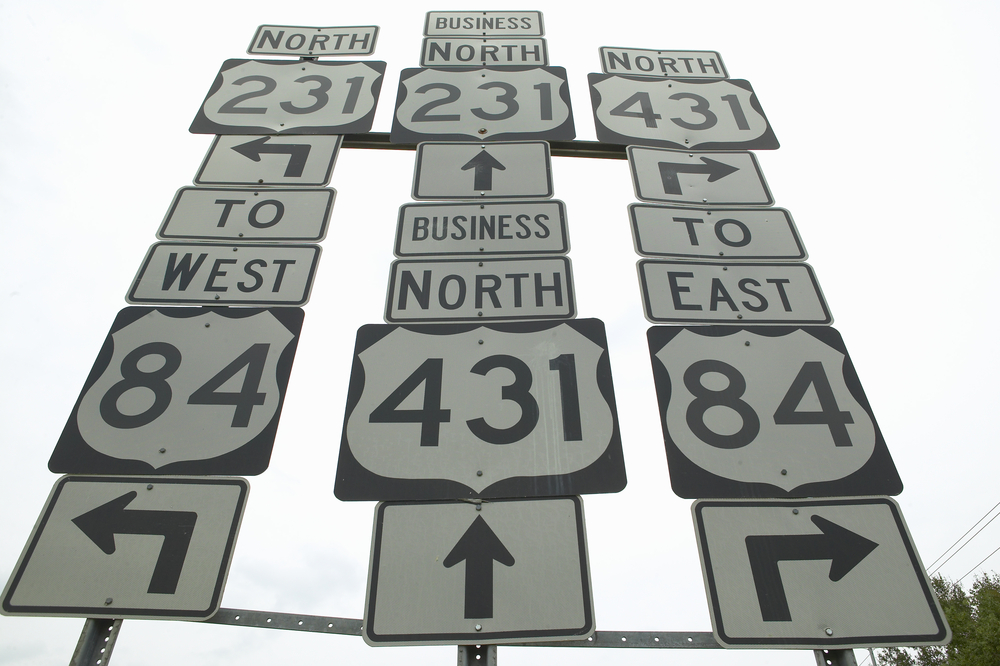
US Highway 431: A Closer Look at Alabama’s Most Dangerous Roadway
US Highway 431 traverses Alabama, linking communities from Dothan to Phenix City, Anniston, Gadsden, Albertville, and Huntsville, before continuing into Tennessee. Renowned for connecting key economic hubs, this route unfortunately also bears an infamous reputation as one of America’s most dangerous highways, earning the grim title “Alabama’s Highway to Hell.” In this article, we’ll take a closer look into the history, the inherent risks, and the concerted efforts to make US Highway 431 safer for all.
The Evolution of US Highway 431
US Highway 431’s journey through Alabama is not just a route on a map; it’s a timeline of growth, development, and transformation. This section chronicles the highway’s evolution, marking significant milestones that have shaped its identity and impact on the state.
- The Early Days (1953): US Highway 431 was established as an auxiliary route of US Highway 31. It was designed to serve the eastern reaches of Alabama, creating a north-south corridor that would facilitate movement and spur economic activity.
- Replacing and Expanding (1953 and Beyond): The new highway took over the path of the former US Highway 241 from Anniston north to the Tennessee state line, marking a significant expansion and rerouting. Additionally, it replaced Alabama Highway 37 south from US Highway 78 to Opelika, effectively reshaping the state’s transportation landscape.
- Catalyst for Growth: As US Highway 431 stretched through Alabama, it became a catalyst for regional growth. Towns and cities along the route, like Albertville, Boaz, and Guntersville, began to thrive, experiencing significant population increases and economic development.
- Population Boom: Reflecting the highway’s impact, the population in Marshall County and other areas along the route saw notable growth. The U.S. Census Bureau reports that the population more than doubled in certain regions from 1950 to recent years, underscoring the highway’s role in fostering community development and urbanization.
- Modern-Day Challenges (2016 and Beyond): While US Highway 431 significantly contributed to the development and connectivity of Alabama’s communities, its increase in traffic and changes in landscape brought about new challenges. The highway’s reputation as a dangerous route began to overshadow its economic benefits, leading to calls for action and improvements.
The Deadly Reputation of US Highway 431
Despite its critical role in connecting communities and fostering economic growth, US Highway 431 has garnered a notorious reputation, leading to its grim label as “Alabama’s Highway to Hell.” This section delves into the factors that contribute to the highway’s dangerous status and the consequences that have necessitated urgent actions for safety improvements.
- ⚠️ Changing Landscape and High Speeds: The highway’s route through diverse terrains, including rural stretches and mountainous areas, combined with high-speed limits, significantly increases the risk of fatal accidents. The abrupt transition from high-speed rural roads to congested town centers exacerbates this risk.
- ⚠️ Sudden Lane Shifts and Stops: US Highway 431 has a tendency to change from four lanes to two lanes without much warning, which can create confusion and dangerous merging situations. This, coupled with the frequent need for sudden stops in small towns along the route, poses a significant hazard to unwary drivers.
- ⚠️ Inadequate Lighting and Visibility Issues: Many sections of the highway, especially the rural stretches, suffer from poor lighting, making nighttime driving particularly perilous. The issues of low visibility are compounded by the road’s winding nature and unexpected curves, hiding oncoming traffic and potential obstacles.
- ⚠️ Heavy Traffic and Intersection Challenges: The highway’s intersections with other major roads, such as Highway 231, Highway 53, and Highway 72, introduce complex traffic patterns and heavy vehicular activity. The high volume of vehicles entering and exiting the highway increases the potential for collisions.
- ⚠️ Distractions and Rapid Decision-making: Drivers on US 431 must constantly adjust to changing road conditions, manage distractions, and make swift decisions. This continuous need for vigilance and the potential for distraction significantly contribute to the highway’s dangerous conditions.
The combination of these factors has not only cemented US Highway 431’s reputation as a perilous route but also highlighted the urgent need for comprehensive safety measures. The subsequent sections will explore the steps Alabama has taken to address these safety concerns and the ongoing challenges that persist in ensuring the highway is a safe passage for all.
Steps Toward Safer Travels on US Highway 431
Acknowledging the grave concerns surrounding US Highway 431, Alabama has embarked on a mission to transform this treacherous road into a safe thoroughfare. This section highlights the major initiatives, the investments, and the strategic planning undertaken to mitigate the dangers and enhance the overall safety of the highway.
Strategic Four-Lane Expansions
- Expansion Projects: Recognizing the need for wider and safer roads, the Alabama Department of Transportation (ALDOT) initiated projects to expand critical sections of US Highway 431 to four lanes. This expansion aims to provide more room for vehicles, thereby reducing the risk of head-on collisions and making the highway more accommodating for increasing traffic volumes.
Enhanced Traffic Control and Infrastructure Improvements
- Traffic Study and Analysis: In response to the escalating safety concerns, comprehensive traffic studies were conducted to assess patterns and identify critical intervention points. The findings of these studies laid the groundwork for a series of targeted improvements.
- Intersection Redesign: Key intersections, notorious for accidents and heavy traffic, were earmarked for redesign to streamline vehicle flow and minimize conflict points. These redesigns include altering traffic patterns and, in some cases, restricting direct crossings on US 431 to reduce the potential for accidents.
- Traffic Signal Optimization: Efforts were made to optimize traffic signals, especially in urban stretches where the highway intersects with other major roads. Synchronizing traffic lights and upgrading to more advanced signaling technologies are part of the comprehensive approach to manage traffic more effectively and safely.
The journey towards making US Highway 431 safer is ongoing, requiring the dedication of community leaders, strategic planning, and the support of the residents to shape a safer future.
5 Driver Safety Tips for Dangerous Roads Like US Highway 431
Driving on roads with a notorious reputation for accidents requires heightened awareness and proactive safety measures. On routes like US Highway 431, known for their challenging conditions, drivers can significantly reduce risks by adopting a vigilant and cautious approach. This section provides essential tips to optimize driver safety on such dangerous roads.
#1 Adhere to Speed Limits
- Understand the Importance: Recognize that speed limits are set based on the road’s characteristics, traffic conditions, and safety considerations.
- Stay Within Limits: Always adhere to the posted speed limits, especially in areas with frequent changes in road conditions or traffic patterns.
#2 Stay Distraction-Free
- Minimize Distractions: Keep your focus on the road. Avoid using mobile devices, adjusting the radio, or any other activity that could divert your attention.
- Stay Alert: Be prepared for sudden stops, changes in traffic flow, or unexpected obstacles.
#3 Anticipate Road Conditions
- Know the Route: Familiarize yourself with the road’s characteristics, including areas known for poor visibility, frequent lane changes, or high accident rates.
- Weather Awareness: Be particularly cautious during adverse weather conditions. Rain, fog, or ice can drastically alter the road’s safety dynamics.
#4 Practice Defensive Driving
- Maintain Safe Following Distances: Give yourself enough space to react if the car in front of you makes a sudden stop or turn.
- Be Visible: Use your headlights and signals appropriately to ensure other drivers can see you and anticipate your actions.
#5 Stay Up-to-Date on Vehicle Maintenance
- Vehicle Readiness: Ensure your vehicle is in good condition, with special attention to brakes, tires, and lights. A well-maintained vehicle is crucial for safe driving on challenging roads.
By implementing these safety measures, drivers can significantly mitigate the risks associated with traveling on roads like US Highway 431. While it’s crucial to advocate for and support roadway improvements, individual actions and responsible driving play an equally important role in ensuring a safer journey for all.
Jay Pickering Law Firm Is On Your Side and Ready To Help
Navigating the aftermath of a car accident can be a difficult. At Jay Pickering Law Firm, we understand the challenges — physical, emotional, and financial — that define these situations. Our firm is here for you, offering wide-ranging experience in personal injury cases. We are committed to protecting your rights and fighting for the compensation you deserve. Reach out anytime for a 100% free consultation — an experienced Birmingham car accident attorney is ready to answer your questions and advocate for you.

Attorney Jay Pickering brings over 27 years of unwavering dedication to personal injury law, with a sharp focus on representing those injured in car, truck, and motorcycle accidents across Alabama. A proud alum of the University of Alabama School of Law, Jay is a member of the Alabama State Bar and the American Bar Association.
